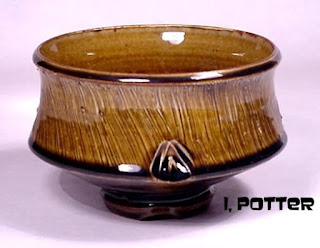Illustrated is an Albany celadon teabowl with a brushed slip surface and stamps placed at four points of the bowl. The rich glaze pools and presents as a dark glass on the lip and the base just prior to the bowl form tapering down to the foot. The richness and visual depth of these glazes made Albany slip one of the greatest materials I have ever worked with along with spodumene and lepidolite. With any luck and lots of testing I will be able to recreate this glaze without using the material itself and if all else fails, I have the actual chemical to fall back on.
Monday, April 11, 2016
TO ALBANY AND BACK
I am currently making up a
large number of tests which includes an ash line blend trying to combine my old
ash glaze with several glazes I am currently using as well as several glazes empirically formulated to be equivalent
to Albany slip formulas. As for the ash glaze, I am using one of the first
recipes I ever used, a dependable formula that works in solo or combo glaze
applications; the purpose of these tests is to try to introduce it in varying
percentages in to formulas that use other existing glazes I currently have in
rotation. Over the years I have had some great results by combing two glazes
into one formula and am hoping to get a few results that at the very least show
some promise or potential. In regards to the Albany tests, though I have been
able to squirrel away a nice supply of the material, I am constantly working on
glazes that exhibit the same results and surfaces without using the nearly irreplaceable
chemical. Over the years I have had varied results and the glazes made out of
my terra cotta body with various additions has come the closest to the result I
am after with each series of tests and alterations I get closer to the
"end result". Always testing, I doubt I can leave things well enough alone
and hopefully this series of ash and Albany-esque tests will be reason enough
for all the effort.
Illustrated is an Albany celadon teabowl with a brushed slip surface and stamps placed at four points of the bowl. The rich glaze pools and presents as a dark glass on the lip and the base just prior to the bowl form tapering down to the foot. The richness and visual depth of these glazes made Albany slip one of the greatest materials I have ever worked with along with spodumene and lepidolite. With any luck and lots of testing I will be able to recreate this glaze without using the material itself and if all else fails, I have the actual chemical to fall back on.
Illustrated is an Albany celadon teabowl with a brushed slip surface and stamps placed at four points of the bowl. The rich glaze pools and presents as a dark glass on the lip and the base just prior to the bowl form tapering down to the foot. The richness and visual depth of these glazes made Albany slip one of the greatest materials I have ever worked with along with spodumene and lepidolite. With any luck and lots of testing I will be able to recreate this glaze without using the material itself and if all else fails, I have the actual chemical to fall back on.
Subscribe to:
Post Comments (Atom)

No comments:
Post a Comment